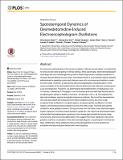Spatiotemporal Dynamics of Dexmedetomidine-Induced Electroencephalogram Oscillations
Author(s)
Akeju, Oluwaseun; Vazquez, Rafael; Rhee, James; Pavone, Kara J.; Hobbs, Lauren E.; Purdon, Patrick L.; Kim, Seong-Eun; Brown, Emery Neal; ... Show more Show less
DownloadAkeju-2016-Spatiotemporal Dynamics of Dexmedet.pdf (11.69Mb)
PUBLISHER_CC
Publisher with Creative Commons License
Creative Commons Attribution
Terms of use
Metadata
Show full item recordAbstract
An improved understanding of the neural correlates of altered arousal states is fundamental for precise brain state targeting in clinical settings. More specifically, electroencephalogram recordings are now increasingly being used to relate drug-specific oscillatory dynamics to clinically desired altered arousal states. Dexmedetomidine is an anesthetic adjunct typically administered in operating rooms and intensive care units to produce and maintain a sedative brain state. However, a high-density electroencephalogram characterization of the neural correlates of the dexmedetomidine-induced altered arousal state has not been previously accomplished. Therefore, we administered dexmedetomidine (1mcg/kg bolus over 10 minutes, followed by 0.7mcg/kg/hr over 50 minutes) and recorded high-density electroencephalogram signals in healthy volunteers, 18–36 years old (n = 8). We analyzed the data with multitaper spectral and global coherence methods. We found that dexmedetomidine was associated with increased slow-delta oscillations across the entire scalp, increased theta oscillations in occipital regions, increased spindle oscillations in frontal regions, and decreased beta oscillations across the entire scalp. The theta and spindle oscillations were globally coherent. During recovery from this state, these electroencephalogram signatures reverted towards baseline signatures. We report that dexmedetomidine-induced electroencephalogram signatures more closely approximate the human sleep onset process than previously appreciated. We suggest that these signatures may be targeted by real time visualization of the electroencephalogram or spectrogram in clinical settings. Additionally, these signatures may aid the development of control systems for principled neurophysiological based brain-state targeting.
Date issued
2016-10Department
Massachusetts Institute of Technology. Department of Brain and Cognitive SciencesJournal
PLOS ONE
Publisher
Public Library of Science
Citation
Akeju, Oluwaseun; Kim, Seong-Eun; Vazquez, Rafael; Rhee, James; Pavone, Kara J.; Hobbs, Lauren E.; Purdon, Patrick L. and Brown, Emery N. “Spatiotemporal Dynamics of Dexmedetomidine-Induced Electroencephalogram Oscillations.” Edited by Nader Pouratian. PLOS ONE 11, no. 10 (October 2016): e0163431. © 2016 Akeju et al
Version: Final published version
ISSN
1932-6203